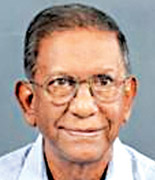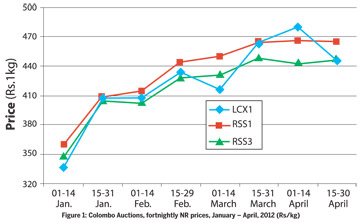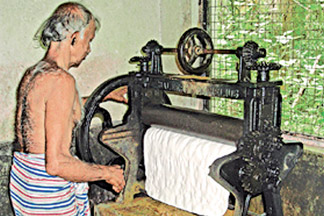Sri Lanka's rubber industry needs 21st century thinking
Dr N Yogaratnam
Sri Lanka is one of the nine major producers of Natural Rubber (NR)
in the world. In terms of productivity, it is now the third best.
However, if Sri Lanka is to retain, or better still, improve its
position in the fast expanding and increasingly competitive global
rubber business in the next ten years, it has to pull itself up by the
bootstraps, smoothen the many rough edges, and adopt new technologies
and practices, suited to the local agro-climatic and socio-economic
conditions.
 |
|
Dr N
Yogaratnam |
Despite impressive progress in the Sri Lankan rubber industry, it is
still plagued by a series of critical issues such as declining planted
area, labour shortage -more specifically skilled tappers, low land and
labour productivity, an ageing labour force, inadequate resources, and
high cost of production.
Present scenario
Rubber is grown in the rain fed low lands of the South Western,
Southern and Central parts of Sri Lanka, though the dry, medium higher
ground is also being explored now with varying degrees of success.
Rubber is grown in as many as 15 districts. But the top growers are:
Kegalle, Kalutara and Ratnapura, with Colombo being a distant fourth.
However, the area under cultivation had fallen sharply since the
1970s, when over 200,000 hectares were under rubber. By 2004, only
115,300 ha were under rubber. This increased to 124,300 ha in 2009. The
total extent is now 127.5 ("000) hectares of which the area in tapping
is 101,720 ha. The area under tapping increased from 89,000 in 2004 to
95,300 in 2009 to 101,720 in 2011.
The rubber tree has to be replanted every 30 years. However, the area
under re-planting has been modest. It was 5200 ha in 2007; 1000 ha in
2008; and 3,600 ha in 2009. The government wants to increase the new
planting area to 40,000 ha, but this appears to be unlikely to be
achieved due to technical as well as non-technical reasons, and also
because increases in rubber prices seem to act as a discouraging factor
on re-planting.
Rubber production had been increasing in Sri Lanka, from 94.7 million
kg in 2004 to 136.9 million kg in 2009 and was 157.9 million kg in 2011,
which was a 3.2 percent increase over the figure for 2010.
The Global as well as domestic NR prices continue to be remunerative
to growers, although they show signs of volatility, as was in the past
(Figure 1).
Productivity
Rubber has witnessed a ten fold increase in productivity in the last
133 years. In the early days, it was only 300 to 400 kg per hectare per
year, due to the use of unselected seedlings. But later, genetically
improved clones secured yields exceeding 3000 kg per ha when grown under
optimum conditions.
In Sri Lanka, it was only 653 kg per ha in 2001. But in 2004, it had
shot up to 1064 kg per ha. In 2009 it was 1437 kg per ha. The yield in
2010 was 1683 kg per ha, and in 2011, it was 1728 kg per ha.
However, the Sri Lankan yield has been lower than those of India and
Vietnam. In 2011, India recorded the highest yield with 1835 kg per ha
of tapped area. Vietnam came second with 1733 kg per ha. Sri Lanka was
in the third place with 1728 kg per ha; and Thailand was fourth with
1688 kg per ha.
In the popular imagination, Malaysia is the home of rubber. But the
yield there is just 1500 kg per ha in 2011. The figures for the other
countries are: Philippines, 1533 kg/ha; Cambodia, 1150 kg/ha; China,
1144 kg/ha; and Indonesia, 1057 kg/ha.
Long way to go
The present Sri Lankan national yield is less than 50 percent of the
achievable. The corporate sector's yield is about 40 percent of the
maximum potential. However, going by the standards achieved by other
leading global rubber producers, and given the operational skills of Sri
Lanka's scientific and management personnel, it should not be difficult
for Sri Lanka to meet these targets, if a genuine effort is made.
The foremost challenge before research institutions and the rubber
industry here is to develop a golden clone which will not only be very
high yielding but also have other positive attributes, such as
compatibility with over exploitation, low frequency tapping without loss
of yield and so on. Research efforts have to be given top priority.
Exceptional performers at the micro level have to be selected and
efforts should be made to replicate their work rapidly. There should be
hybridization of selected parents for subsequent selection of potential
clones. Bio-technology should be used to improve the genetic make up of
the trees.
If Sri Lankan scientists and plantation firms fail to do these, MNCs
may bring out genetically altered transgenic rubber clones for sale to
rubber producing countries at exorbitant prices.
There may be royalty claims too.
Antibiotics from rubber
It is possible to alter the technological properties of rubber so
that more uses could be found for the product. He believes that the
rubber tree could be a future factory for the production of antibiotics
and that attempts are already being made to do so.
A wide variety of rubber products are now manufactured in Sri Lanka.
The country has the potential to be one of the world's leading rubber
product manufacturers due to its high quality raw materials; top grade
natural rubber with very low level of proteins; and the relatively low
processing cost.
Among the rubber products made in the island are: surgical, household
and agricultural gloves, balloons, hallowing masks and rubber toys. The
latex or rubber industry has expanded significantly in the last decade
and it presently accounts for about 35 percent of the local consumption
of natural rubber.
The leading Sri Lankan manufacturers of rubber products in the island
are: Ansel Lanka; DSI; Loadstar; Hanwella Rubber Products; Lalan Group;
Dipped Products; Trelleborg; Associated Motorways; and Richard Peiris.
Rising domestic use
Much of the rubber and rubber products produced by Sri Lanka is
consumed locally. In 2009 for example, 84.09 million kg were locally
consumed and 56 million kg were exported. The items exported were tyres,
tyre cases, tubs, plates, sheets and strips, surgical and other gloves,
floor coverings and mats.
 In 2009, exports of natural rubber were worth Rs.11.3 billion and
those of manufactured rubber products, Rs.44.3 billion. The total
exports were worth Rs.56 billion. In 2010, the total had gone up to
Rs.64 billion. In 2009, exports of natural rubber were worth Rs.11.3 billion and
those of manufactured rubber products, Rs.44.3 billion. The total
exports were worth Rs.56 billion. In 2010, the total had gone up to
Rs.64 billion.
Previously, however, exports outstripped domestic consumption. Even
as recently as in the 1990s, domestic consumption was to the tune of
just 21 to 35 percent, but now it has gone up to about 65%.
The change which occurred in the last decade or so is attributed to
the emergence of local rubber based industries.
Out of the 136, 880 metric tones produced in 2009, 54,550 mt went
into the manufacture of sheets, 31,000 mt went into the manufacture of
latex crepe, and 29,934 mt into the making of centrifuged latex and
other products. As for exports, sheets accounted for the bulk. Again, in
2009, out of the 55,991 metric tones of exports, sheets accounted for
24,402 mt, and latex crepe 13,683 mt.
Small holders and SMEs
Most of the land under rubber in Sri Lanka is under small holders,
who number about 130,000 families, concentrated in the Low Country Wet
and Intermediate Zones. In 2009, out of a total of 124,300 hectares,
72,719 ha were under small holders and 51, 581 ha under the "estate
sector".
However, over the years, there has been a sharp decline in the area
under small growers.
In 1990 for example, out of a total of 199,048 hectares, 139,488 ha
were under small growers and only 59,560 were under the big holders or
the estate sector.
A study of the key socio-economic characteristics of the new small
holder rubber cultivators in Moneragala district shows that they are
uneducated, though on an average they are young, that is, under 50 years
of age. The average level of education is primary. This is a constraint
to the adoption of new techniques for improving productivity. Another
factor impacting productivity is the low level of income. It is just
Rs.10,000 per month.
Strategic small holdings
The socio-economic profile of this key sector of the Sri Lankan
population calls for the treatment of the small scale rubber sector as a
strategic sector needing urgent attention. This sector should be the
target for special ameliorative measures and state aid, because the
established or "mature" rubber cultivators earn more, on an average,
Rs.25,000 per month. The awareness level among the "immature"
cultivators of techniques of maintaining land was just 21 percent. And
about disease control, the awareness was 34 percent. Awareness of
planting methods, inter-cropping and soil fertility management was
moderate (49, 45 and 50 percent respectively). The study found that
awareness of the proper tapping method was below 40 percent.
Inferior quality plants
In the immature holdings, the number of plants per hectare is lower
than the recommended 500 plants per hectate.
The farmers cite drought and the poor plants given to them as reasons
for not planting as many trees as they should. In 97 percent of the
holdings, cover crop is not present. Weed control is practiced in 98
percent of the cases, but the recommended method is not followed.
 However, the small holders get a fertilizer subsidy, and 78 percent
use it. More that 60 percent use it in the recommended way. However, the small holders get a fertilizer subsidy, and 78 percent
use it. More that 60 percent use it in the recommended way.
Mature fields
In the "mature" fields too, the number of trees per hectare is less
than the recommended number. It is 414 per ha, and not 500. The number
of trees which can be tapped is even less at 268 trees per ha. Farmers
give drought as the reason for the deficit but the poor quality of the
plants is also cited as a reason.
Fertilizer was not applied in 54 percent of the mature holdings. But
the method of application accorded with the prescribed method in 57
percent of the cases. The study says that due to high demand for
planting material, poor quality planting material had been supplied in
some cases.
Grower efficiency
Scientific measurements of the efficiency in rubber cultivation
showed that the greater the extent of land, better the efficiency. But
farmers find it difficult to get land for rubber cultivation.
They had not received permits from the Divisional Secretariats for
cultivation. Nearly 53 percent of the farmers said that they were
occupying state land on lease or having Swarnabhoomi or Jayabhoomi
deeds. Some were encroachers.
Delay in subsidy payments, marketing problems, and lack of training
facilities were also cited as reasons for poor productivity in the small
scale sector.
Problems of mature farms
Production efficiency levels in mature rubber lands in Moneragala
district averaged 59 percent, which meant that 41 percent of the
potential maximum productivity was lost due to inefficiency.
Those who tapped their own trees showed highest efficiency levels
than those who employed non family workers. A family which tapped its
trees showed an efficiency of 60 percent and that which employed
outsiders showed 55 percent. Those who had an education of GCE O/L
showed an efficiency of 62 percent, while those with a lower educational
qualification showed an efficiency level of 57 percent.
Value chain
The value chain assessment showed that in Sri Lanka's the failure of
an appropriate and working technical support and monitoring system has
resulted in:
a) Low spread of high yielding clonal planting material
b) Failure to halt spread of low yielding clones
c) Poor cultivation practices which result in 50% - 70% less
productivity in both traditional as well as in non traditional areas
d) Proliferation of poor tapping practices which reduce the tapping
lifespan by around 10 years, i.e. 50%.
e) Very limited recognition of the environmental benefits of rubber
agro forestry in designing replanting programs.
In conclusion it is recommended that proper extension programmes,
especially in the non-traditional rubber growing areas keeping in mind
the poor educational status of the farmer. It is also stressed the need
to monitor the use of the government subsidy to minimize the wastage of
scarce resources.
|



